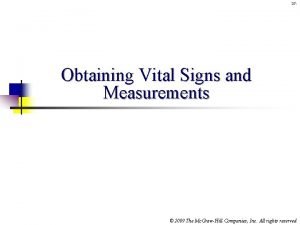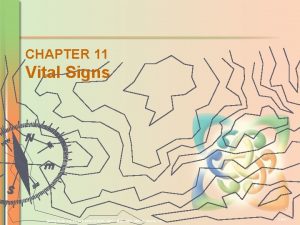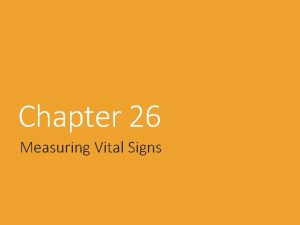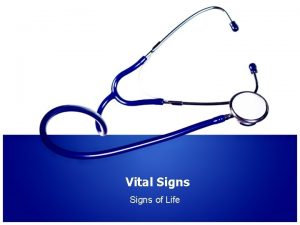Chapter 16 Testing Madelynne Mc Donald Vital Signs











- Slides: 11

Chapter 16 Testing -Madelynne Mc. Donald-

Vital Signs n Temperature n Elevated body temperature is called Febrile or Pyrexia (fever). n Afebrile means without fever. n Hypothermia is a decrease in body temperature

Vital Signs n Pulse Number of times the heart beats per minute is called the Pulse Rate and is taken by palpating an artery. n Heart Rate is the number of times the heart contracts and relaxes per minute and is taken by auscultating the heart with a stethoscope. n

Vital Signs Respiration Rate is the number of respirations per minute, classified as one total inhale and one total exhale. n Blood Pressure n A sphygmomanometer is used to measure blood pressure. n A Doppler is used to listen to blood sounds during the measurement of blood pressure in animals. n

Blood Test Terms Venipuncture: withdrawing blood from a vein. n Assay: assessment or test to determine the number of organisms, cells, or amount of a chemical substance found in a sample. n Complete Blood Count: diagnosis evaluation of blood to determine the number of erythrocytes, leukocytes, and thrombocytes per cubic millimeter of blood. n

Blood Test Terms n n Profile: group of laboratory tests performed on serum; also called screen or panel. Includes tests that measure levels of glucose, liver enzymes, and kidney enzymes. Red Cell Count: number of erythrocytes per cubic millimeter of blood Serology: lab study of serum and the reactions of antigens and antibodies White Cell Count: number of leukocytes per millimeter of blood.

Types of Diseases Contagious Disease: disease that can be spread from one animal to another by direct or indirect contact (a. k. a. communicable). n Iatrogenic Disease: disorder caused by physicians or veterinarians. n Idiopathic Disease: disorder with an unknown cause n Nosocomial Infection: disorder caused by pathogenic organisms contracted in a facility or clinic. n

Examinations Endoscopy: the visual examination of the interior of any cavity of the body by means of an endoscope. n Centesis: the surgical puncture to remove fluid or gas for diagnostic purposes or for treatment. n

Imaging Techniques n Radiography: the procedure in which film is exposed as ionizing radiation passes through the patient and shows the internal body structures in profile. Projection: the path of the x-ray beam n Positioning: the specified body position and the part of the body closest to the film n

Imaging Techniques Computed Tomography: the procedure in which ionizing radiation with computer assistance passes through the patient and shows the internal body structures in cross -sectional views. n Magnetic Resonance Imaging: the procedure in which radio waves and a strong magnetic field pass through the patient and show the internal body structures in 3 -D views. n

Imaging Techniques Fluoroscopy: the procedure used to visually examine internal body structures in motion using radiation to project images onto a fluorescent screen. n Ultrasound: imaging of internal body structures by recording echoes of highfrequency waves. n n Echoic: property of producing adequate levels of reflections when sound waves are returned to the transducer and displayed.
 Signs signs everywhere signs meaning
Signs signs everywhere signs meaning Chapter 14:1 measuring and recording vital signs
Chapter 14:1 measuring and recording vital signs Chapter 37 vital signs and measurements
Chapter 37 vital signs and measurements Chapter 29 measuring vital signs
Chapter 29 measuring vital signs Oral temperature
Oral temperature Chapter 16.2 measuring and recording temperature answer key
Chapter 16.2 measuring and recording temperature answer key Body measurements and vital signs chapter 36
Body measurements and vital signs chapter 36 Fundamentals of nursing chapter 17 vital signs
Fundamentals of nursing chapter 17 vital signs Chapter 27 measuring vital signs
Chapter 27 measuring vital signs Test chapter 16 vital signs
Test chapter 16 vital signs Where is apical pulse taken
Where is apical pulse taken Chapter 11 vital signs
Chapter 11 vital signs





















